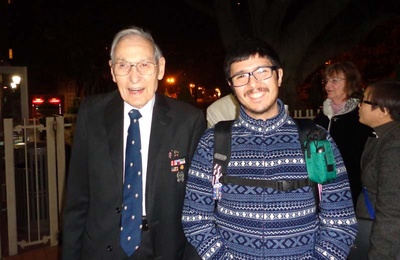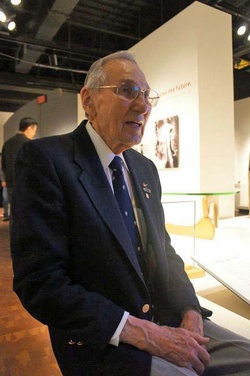Identity is a fickle concept. When we talk about “ethnicity” and its ties to identity, we are engaged in a delicate balancing act, making meaning out of how we feel about ourselves and how others view us. Multiethnicity provides a compelling model of this negotiation; “authenticity” fundamentally boils down to an argument over “blood” and “culture,” between what others see and what’s in our hearts.
As a mixed Chinese American and a UCLA Asian American Studies graduate student, I deal with these complexities personally and professionally on a daily basis. My position as an “ethnic outsider” who researches Japanese experiences renders me vulnerable to criticism yet conscious of the problematic nature of terms like “ethnicity” as constrictive. I also share a sense of connection with many multiethnic Japanese American friends and colleagues. However, despite my earnest attempts at objectivity, I sometimes find my “experience” runs counter to what some consider the “truth.”
Meeting Virgil Westdale, a 95 year old Nisei (a label I use to historically situate his connections to Japanese American legacies), self-designated Japanese American, and 442nd Veteran, indirectly taught me new ways of understanding multiethnic identity and the potential gap between scholars and subjects of study. His way of conceptualizing identity not only redefined who can be considered Japanese American, but disrupted my assumptions about being “mixed.” This brief field-note summary explores a dynamic Nikkei experience as well as my reflections on how my research goals potentially overshadowed the integrity of my work.
I listened to Virgil speak at USC as part of the Hapa Japan Conference 2013 lecture series. Billed as a pluralistic Nikkei history, his story is particularly alluring since he was brought up relatively isolated from other Japanese Americans in the Mid-West during a time when there were few multiethnic Japanese.
Immediately, I was struck by Virgil’s physical appearance. I expected to see a man of “average” stature with visibly “mixed” features, who “appeared Japanese” but looked distinct. Had I not known he was “mixed,” I would have assumed he was a rather typical looking Caucasian man, not unlike my own grandfather. Even after examining old photographs, I was still in disbelief; Virgil, the half-Japanese war hero, did not look “stereotypically” mixed. I began to reflect; while there is no such thing as a universal “Japanese look,” why had I assumed there was a “mixed look”?
Virgil noted how physical ambiguity fostered an indifferent outlook towards his Japanese ancestry, elaborating this point through various stories. Camp Shelby was the first time he was “surrounded by Asians,” realizing just how physically different he appeared. He recalled fellow 442nd soldiers mistaking him for a lost Caucasian soldier. For the first time, Virgil was close yet remained distant from other Nisei; physically present yet visibly and spiritually detached.
Physical difference was not the only thing that made Virgil feel like an outsider. He was born Virgil Nishimura, not Westdale. Beside phenotype, names are one of the easiest ways to distinguish ethnicity, at least on paper. Well before the war, the family talked about legally changing their name and “Americanizing.” As an adult, Virgil transliterated his name to Westdale (西村, Nishi—West, Mura—Village). By doing so, Virgil consciously affirmed his identity as an American, first and foremost. But why, I wondered, was he compelled to essentially erase what remained of his “ethnicity”?
His answer was simple; it was easier to say, spell, and most accurately reflected the way he felt. Up to joining the 442nd, Virgil’s only real connection to Japan was his father. His family did not learn Japanese language and had very little “cultural knowledge” beyond the use of chopsticks. They farmed the same vegetables, attended the same schools, and participated in the same community events as their Caucasian neighbors. There was no Japanese school, no ethnic community, and their father was vocally disinterested in “cultural education.” Besides the “race” factor, they were really no different than other Americans. While Virgil admits he likely faced some discrimination, it was not significant enough to linger in his memory.
The power of Virgil’s words indicates he is a man who is sure of himself and his place in the world. One memory of discrimination was particularly convincing. In his youth, Virgil trained for several years to become a pilot. After the bombing of Pearl Harbor, the War Department revoked Virgil’s pilot license because his Japanese ancestry deemed him a “threat.” The racialization of “half” his ancestry essentially ruined his life. Though reinstated 5 months later into the Army Air Corp, he was soon forced to give up flying again and serve in the 442nd. Virgil told us this moment tried his soul; to be judged twice, to lose his life based on race regardless of having no realistic attachment to a Japanese identity, was devastating. Despite being born an American, like other Nisei, race became the pretext for injustice.
I was perplexed; how was he able to so easily refuse ethnic categorization while being “consciously aware” of racism’s tangible consequences? Did racialization make him feel more “Japanese”? Would he always feel “in-between”?
Though undoubtedly Japanese American, Virgil told us that race and racism had not defined him. He served proudly because he believed in his country, he flew airplanes because they were his passion, and he loved his fellow soldiers because they were good people. He acknowledged that he felt connected to the Japanese American experience, had been racialized, and was attached to his father’s nation symbolically, never denying his mixed-Caucasian roots. However, he was more concerned with being an honest citizen, soldier, pilot, citizen, father, son, and friend than the politics of identity. Japanese identity was present, but secondary.
Virgil even conceptualized “ethnicity” differently. He often used “nationality” and “ethnicity” interchangeably. While I pondered his “mistake,” a thought came to mind: perhaps this was just his way of understanding identity.
As the lecture came to a close, I realized I had assumed my prior knowledge of “multiethnic” experiences gave me “legitimate” insight into Virgil’s life. Rather than listening to his words, I was constantly searching for the how-and-why, expecting an answer. Was I hijacking his story without considering the most important element: his own opinion and consciousness? Could something as fundamental as a personal interpretation be overshadowed by academic thinking? While not malicious, I had “expected” a man who was part of the Hapa Japan Conference, a 442nd war hero, and a representative of Nisei experiences to be able to “perform” a particular identity.
As the Q&A began, the gap between “academic thought” and Virgil’s lived-experiences became apparent. While young minds railed-off questions about “the state,” ethnic paradigms, race ecology, and the current state of multiethnic race politics, Virgil gently approached each loaded inquiry with simplicity, noting that such issues did concern him.
This gap between how the audience and Virgil conceptualized identity was based on our expectation of “universal applicability.” What we learn in universities about Nikkei lives and ethnic theories reflects certain “realities.” But I remained conflicted; must our academic views align with our subjects? Can we ever hope to include every perspective? Rather than try to “analyze,” should I simply venerate the narrative, allowing it to guide my understanding? Or do we possess authority as scholars to engage in deep analysis? I recognize that ethnicity is not salient for every individual or relevant to every experience, and that multiethnicity is not conceptualized universally. However, as outside observers, can we detect dynamics that our subjects may be unaware of, such as in the case of Virgil Westdale, internalized racism? Is external analysis necessary for objectivity?
Over dinner after the lecture, I learned more about the depth of Virgil’s narrative. In the back of my mind, I was still waiting for the “answer.” I caught myself wanting to call him Mr. Nishimura, perhaps hoping he would suddenly announce, “Yes, I am a mixed Japanese American, here’s the story you want to hear.” It would have made my research easier, but that moment never came. Though both the man and the promise he embodied “failed” to meet my expectations, perhaps I had failed to see the value in his contrasting perspectives.
In the end, I am left with more questions than answers. As a researcher, I am interested in analysis. What factors caused his positive self image? What does his participation in Japanese American history mean to others? Are his views of the 442nd and the US congruent with other Japanese American perspectives? Despite his honesty, was there hidden chaos?
This experience helped me reconcile with issues of ethics regarding my methods and preconceived notions about multiethnic experiences. As a scholar, I am responsible for analyzing narratives and avoiding bias. At the same time, I am also tasked with uncovering the deeper meaning of content to address broader issues of race, identity, and historicity. Is there a way to maintain the integrity of his perspectives, apply my analysis, and utilize our contrasting words constructively? I believe is it my duty to take these stories a step further and give them purpose as well as merit, to revere the subject while offering insight that may be unrecognizable to the individuals themselves.
My encounter with Virgil Westdale offered insight into how academic and non-academic perspectives of identity may differ but are not inherently at odds. Rather, they can inform one another. Through resilience, Virgil had an unconscious “mastery” of his identity which has prevented him from living by the expectations of others. “Outlying narratives” provide unique insight into the phenomenon of “ethnicity” within “irregular” contexts, important parts to a broader history.
Thus, research becomes a balancing act; examining micro-level voices, taking value from their experiences, while pushing the goals of research forward. It is important to reconcile with the gap between what scholars and subjects consider “knowledge,” remaining vigilant of how “academic authority” can overlook the importance of the subjects themselves. I am humbled by Virgil Westdale’s indomitable ability to live his life on his terms, representing an important story of Nikkei and multiethnic experiences.
© 2013 James Ong







